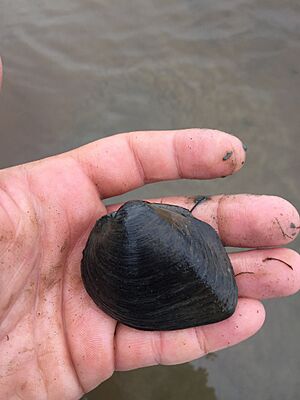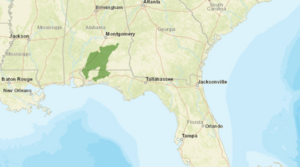Narrow pigtoe facts for kids
Quick facts for kids Narrow pigtoe |
|
|---|---|
 |
|
| Conservation status | |
| Scientific classification | |
| Genus: |
Fusconaia
|
| Species: |
escambia
|
 |
|
| Range map for narrow pigtoe | |
The narrow pigtoe (scientific name: Fusconaia escambia) is a special type of freshwater mussel. It lives in rivers and creeks in Alabama and northwestern Florida. This mussel was first found in the Escambia River.
Contents
What is a Narrow Pigtoe?
The narrow pigtoe mussel has a unique shape, from triangular to almost square. Its shell can be black or a reddish-brown color. Adult narrow pigtoes can grow to about 75 millimeters (3 inches) long. Their shells are quite thick, and the inside is often white or salmon-colored. You might even see a rainbow pattern near the bottom of the inside of their shell!
This mussel is different from other mussels in the Fusconaia family. It has a slightly different shell color. Also, it lives in different places and uses specific kinds of fish to help its young grow up.
Life Cycle and Reproduction
Not a lot is known about the narrow pigtoe's full life story. They usually reproduce between May and July. However, sometimes pregnant females are found as early as March or as late as October. Narrow pigtoes are "short-term brooders," which means they carry their eggs for about 2 to 6 weeks.
Like most freshwater mussels, narrow pigtoes have thousands of babies. This helps make sure that at least some of them will survive and become adults. The eggs are fertilized inside the female mussel's shell. There, they grow into tiny larvae.
These larvae then attach themselves to a host fish. They live on the fish as tiny parasites, getting nutrients from it. This helps them change into young mussels. Once they are ready, the young mussels drop off the fish. They sink to the bottom of the river or creek and grow into adult mussels. The places where narrow pigtoes live often depend on where their host fish are found.
Where Narrow Pigtoes Live and What They Eat
What They Eat
Narrow pigtoes eat by pulling water into their shells. They filter out tiny bits of food from the water using their gills. Adult mussels mostly eat things like dead plant and animal bits (called detritus), algae, and bacteria.
Young mussels, called juveniles, feed differently. They burrow into the ground and use their "foot" to grab food particles. They pull these particles into their shell to eat. They keep feeding this way until they are old enough to filter feed like adults. The tiny larvae feed by taking nutrients from their host fish.
Their Home
Most freshwater mussels like places with slow to medium water currents. They prefer small to medium-sized rivers or creeks. The narrow pigtoe buries itself in the riverbed, which can be sand, gravel, or silt. It needs a stable spot that isn't often disturbed.
As mentioned, where narrow pigtoes live also depends on whether their host fish are in the area. These mussels are sensitive to changes in their environment. They need clean water and a safe home to grow well.
Where They Are Found
The narrow pigtoe is only found in the Escambia and Yellow River basins. These rivers are in northwest Florida and southern Alabama. They flow south into the Gulf of Mexico.
Surveys have shown that narrow pigtoes live in many of their known locations. They have even been found in new places, like parts of Point A Lake and Gantt Lake in Alabama. More research is still needed to fully understand where all the narrow pigtoe populations are.
How They Behave
The mating and reproduction of narrow pigtoes rely heavily on their host fish. When there are many fish, the mussel larvae can easily attach and grow. But if there aren't enough host fish, the larvae might not be able to develop into young mussels.
Adult narrow pigtoes are filter feeders, meaning they strain food from the water. They are better at this once their siphons (tube-like parts) are fully grown. Young mussels use their foot to find and capture food until their siphons are ready.
Protecting the Narrow Pigtoe
Population Changes
We don't know the exact number of narrow pigtoes alive today. However, a survey in 2012 found 166 mussels in the Escambia river system. Studies also show that more surveys have found narrow pigtoes since 2008 compared to before that year. This might mean their population is growing, but it's still not completely clear.
Geographic Range Changes
The narrow pigtoe is still found in most of its known areas. It has also been seen in new places. A 2012 survey found narrow pigtoes at 28 different locations. This is more than the 13 sites found earlier, which suggests the area where they live might be getting bigger.
Threats to the Narrow Pigtoe
We don't know all the dangers facing the narrow pigtoe. However, some possible threats include:
- Loss of river homes: When river habitats are damaged or disappear.
- Poor water quality: Pollution makes it hard for them to survive.
- Big natural events: Things like floods or droughts.
- Invasive species: New plants or animals that move into their habitat and cause problems.
Endangered Species Act Listing
Because it was struggling, the narrow pigtoe was listed as a threatened species under the Endangered Species Act of 1973 (ESA) in 2012. This law helps protect animals and plants that are in danger.
Recovery Plan
A plan to help the narrow pigtoe recover was created in 2012. This plan noted that it would be hard for the mussel to recover fully. The plan suggests three main ways to help save the narrow pigtoe:
- Use existing rules to manage streams better.
- Encourage people to avoid actions that harm river ecosystems.
- Keep doing research to learn more about the narrow pigtoe.
Critical Habitat
Scientists have also identified the "critical habitat" for the narrow pigtoe. This means the specific places they need to live and grow. They need fresh water that is always moving. They also need enough space to grow and find food. We don't yet know exactly how much oxygen or what pH level they need in the water to survive.



